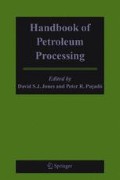Hydrotreating or catalytic hydrogen treating removes objectionable materials from petroleum fractions by selectively reacting these materials with hydrogen in a reactor at relatively high temperatures at moderate pressures. These objectionable materials include, but are not solely limited to, sulfur, nitrogen, olefins, and aromatics. The lighter materials such as naphtha are generally treated for subsequent processing in catalytic reforming units, and the heavier distillates, ranging from jet fuel to heavy vacuum gas oils, are treated to meet strict product quality specifications or for use as feedstocks elsewhere in the refinery. Hydrotreating is also used for upgrading the quality of atmospheric resids by reducing their sulfur and organo-metallics level. Many of the product quality specification are driven by environmental regulations that are becoming more stringent every year. Hydrotreaters are designed for and run at a variety of conditions depending on many factors such as type of feed, desired cycle length, expected quality of the products but in general they will operate at the following range of conditions: LHSV—0.2 to 8.0, H2 circulation—300 to 4,000 SCFB (50–675 Nm3/m3), H2PP—200–2,000 psia (14–138 bars) and SOR temperatures ranging between 550 and 700°F (290–370°C), with the lower limits representing minimum operating conditions for naphtha hydrotreating and the higher values showing operating conditions used for hydrotreating atmospheric resids. Until about 1980, hydrotreating was a licensed technology being offered by a fairly large number of companies. In the past 25 years, hydrotreating catalysts have become commodities and the process has been offered without licensing fees.
The common objectives and applications of hydrotreating are listed below:
-
Naphtha (catalytic reformer feed pretreatment)—to remove sulfur, nitrogen, and metals that otherwise would poison downstream noble metal reforming catalysts
-
Kerosene and diesel—to remove sulfur and to saturate olefins and some of thearomatics, resulting in improved properties of the streams (kerosene smoke point, diesel cetane number or diesel index) as well as storage stability
-
Lube oil—to improve the viscosity index, color, and stability as well as storage stability
-
FCC feed—to improve FCC yields, reduce catalyst usage and stack emissions
-
Resids—to provide low sulfur fuel oils to effect conversion and/or pretreatment for further conversion downstream.
Access this chapter
Tax calculation will be finalised at checkout
Purchases are for personal use only
Preview
Unable to display preview. Download preview PDF.
Author information
Authors and Affiliations
Editor information
Editors and Affiliations
Rights and permissions
Copyright information
© 2008 Springer Science + Business Media B.V
About this chapter
Cite this chapter
Gruia, A. (2008). Hydrotreating. In: Jones, D.S.J.S., Pujadó, P.R. (eds) Handbook of Petroleum Processing. Springer, Dordrecht. https://doi.org/10.1007/1-4020-2820-2_8
Download citation
DOI: https://doi.org/10.1007/1-4020-2820-2_8
Publisher Name: Springer, Dordrecht
Print ISBN: 978-1-4020-2819-9
Online ISBN: 978-1-4020-2820-5
eBook Packages: Chemistry and Materials ScienceChemistry and Material Science (R0)

